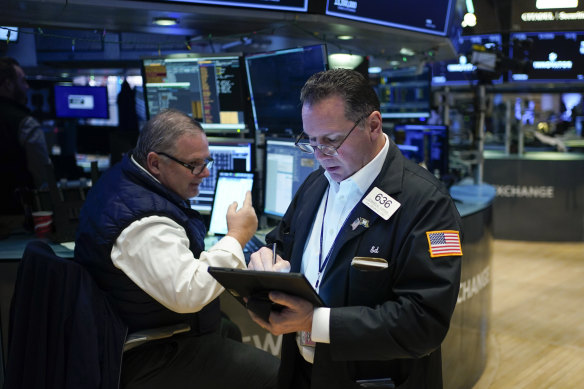ASX jumps higher as Wall Street’s winning run continues
By Millie Muroi
The Australian sharemarket has continued to climb on Friday, pointing to a straight week of gains on the back of strength in US markets and the domestic mining sector.
The S&P/ASX 200 was up 56.7 points, or 0.8 per cent, to 7,179 at the open, as all sectors except energy traded in the green.

The materials sector (up 1.5 per cent) bolstered the local bourse, as a 2 per cent rise in iron ore prices gave heavyweights BHP (up 2.1 per cent), Fortescue (up 1.7 per cent) and Rio Tinto (up 1.3 per cent) a boost. Gold miners Evolution Mining (up 2.8 per cent) and Northern Star Resources (up 1.8 per cent) rebounded from losses on Thursday as the gold price lifted 0.8 per cent. Medibank (up 1.5 per cent) was the only non-mining-related company in the top ten large-cap advancers at the open, gaining despite facing class action from its shareholders over the handling of its cyberattack last year.
The energy sector (down 0.3 per cent) tempered gains on the ASX as Brent crude oil prices dropped 1.4 per cent and heavyweight Woodside shed 0.4 per cent. Logistics company Qube Holdings (down 0.7 per cent) was the biggest large-cap decliner, followed by technology company Computershare (down 0.5 per cent) and manufacturer Incitec (down 0.5 per cent).
On Wall Street, stocks rose Thursday as a bit more fear evaporated, keeping its main index of health on track for a winning month.
The S&P 500 rose by 0.6 per cent higher to cement its fifth gain in the last six days. Its recent roll has it up for the month after struggling in earlier weeks on worries about whether the banking system was cracking under the weight of higher interest rates.
The Dow Jones rose 0.4 per cent and the Nasdaq composite gained 0.7 per cent. The ASX added 1 per cent on Thursday.
Forceful actions by regulators worldwide have helped build confidence that the current trouble for banks won’t torpedo the economy like the 2008 financial crisis did. Traders have also begun betting heavily that the Federal Reserve will have to cut interest rates soon. Such cuts could offer relief after a year of relentless hikes to rates, and they also tend to act like steroids for markets.
To be sure, all the recent ebullience has some professionals on Wall Street wary.
“Markets are pricing the best of both worlds: a recession that brings inflation down rapidly and keeps rates low, yet one where corporate earnings do not fall sharply,” according to analysts at Barclays led by Ajay Rajadhyaksha, global chairman of research.
.
Expectations for easier rates in turn have helped to buoy the Big Tech stocks that dominate the S&P 500 and other indexes. That’s because tech and high-growth stocks are seen as some of the biggest beneficiaries of low rates.
Gains for Microsoft, Apple and Amazon on Thursday were the strongest forces pushing the S&P 500 higher. Amazon rose 1.7 per cent, while the others were up more modestly.
Financial stocks in the S&P 500 went from gains in the morning to losses in the afternoon, and they ended mixed. But the movements weren’t as jagged as they were earlier this month when fears about the banking system were at their height.
A report on Thursday showed that slightly more US workers applied for unemployment benefits last week than expected. That could be a sign of increased layoffs, but the number still remains very low compared with history.
In a separate report, the government revised down its estimate for how much the US economy grew during the last three months of 2022. But it also still showed growth.
“Today’s data may have some investors more willing to see the light at the end of the tunnel for rate hikes but remember a multitude of data will be released before the Fed’s next decision,” said Mike Loewengart, head of model portfolio construction at Morgan Stanley Global Investment Office.
On Friday, the Commerce Department issues its February report on consumer spending. That’s the heart of the US economy. Perhaps more importantly, the report will also give the latest update on the measure of inflation that Fed policymakers prefer to use.
“And we have just seen how quickly the market can be disrupted by unplanned turmoil,” Loewengart said, “so investors should remain alert.”
With AP
The Market Recap newsletter is a wrap of the day’s trading. Get it each weekday afternoon.
Most Viewed in Business
Source: Thanks smh.com